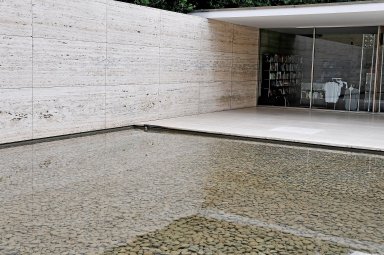Detail View: Archivision Base to Module 9: Barcelona Pavilion

|
Preferred Title:
|
Barcelona Pavilion
|
|
Alternate Title:
|
German Pavilion
|
|
Image View:
|
Court and large water basin, view into the northwest corner
|
|
Creator:
|
Ludwig Mies van der Rohe (German architect, 1886-1969)
|
|
Location:
|
site: Barcelona, Catalonia, Spain
|
|
Date:
|
1929 (creation); 1986 (creation)
|
|
Cultural Context:
|
German
|
|
Style Period:
|
Bauhaus; Modernist; Modern
|
|
Work Type 1:
|
exhibition building
|
|
Classification:
|
architecture
|
|
Material:
|
steel; glass; marble; travertine; onyx
|
|
Technique:
|
construction (assembling)
|
|
Subjects:
|
architectural exteriors; commercial and industrial design; world's fairs
|
|
Description:
|
In 1929 the earlier ideas of Mies van der Rohe were finally realized in one of the most important buildings of the Modern Movement, the German (or Barcelona) Pavilion (destroyed; reconstructed 1986), Montjuïc, Barcelona. It was a last-minute addition to the German section of the Exposición Internacional in Barcelona in 1929 for which Mies van der Rohe and Lilly Reich (with whom he collaborated on exhibition projects) had been given overall design responsibility by the government in 1928. Here Mies van der Rohe used the open (decellurized) plan as an architectural analogy of the social and political openness to which the new German republic aspired. Space-defining elements were dissociated from the structural columns, planning was free and open, merging interior and exterior spaces: unbroken podium and roof planes were held apart by a regular grid of slender cruciform steel columns, giving a clear field for spatial design, using opaque, translucent and transparent walls freely disposed between the columns. The
|
|
Collection:
|
Archivision Addition Module Five
|
|
Identifier:
|
1A1-MVR-BP-B9
|
|
Rights:
|
© Scott Gilchrist, Archivision, Inc.
|